
This article discusses user behavior data, which is data collected by search engines such as Google to study user interactions with SERPs.
It explains what a bounce is, what causes it, and how to avoid it. Understanding user behavior data and avoiding bounces is essential for web admins and website owners to ensure users have a positive website experience.
Introduction
What is User Behavior Data?
What is a Bounce?
What Causes a Bounce?
Conclusion
Introduction: User behavior data is collected by search engines, such as Google, to provide a better search experience and ensure repeat users. This data includes location data, voice search data, mouse movements, and data gleaned from authenticated Google Account usage across various Google products. Understanding user behavior data is essential for web admins and website owners to ensure users have a positive website experience. This article will discuss what user behavior data is, what a bounce is, what causes a bounce, and how to avoid them.
What is User Behavior Data?
User behavior data is collected by search engines, such as Google, to study user interactions with SERPs (search engine result pages) to improve users' overall search experience. This data includes location data, voice search data, mouse movements, and data gleaned from authenticated Google Account usage across various Google products. This data is used to determine how users interact with the SERPs, what types of content they are looking for, and how to improve the overall user experience.
What is a Bounce?
A bounce is when a user quickly abandons a website and returns to the SERP. This can be a negative signal for both search engines and websites as it indicates that something is wrong with the website or that the user experience is negative.
What Causes a Bounce?
There are various reasons why a user may bounce back to the SERP, including slow page load time, poor user interface design, irrelevant content, being presented with interstitial ads or paywalls, or simply by accidentally clicking or tapping the wrong result. Additionally, if the content on the page does not match the user’susers’ expectations, they may quickly abandon the page and return to the SERP.
Conclusion: User behavior data is an essential tool for search engines to provide a better search experience for users. Web admins and website owners must understand user behavior data and how it is used to provide a positive user experience. Additionally, it is necessary to understand what a bounce is and what causes it to avoid them. By understanding user behavior data and avoiding bounces, web admins and website owners can ensure that their website provides a positive user experience.
Optimizing your website for SEO and user behavior is critical to keeping visitors engaged and avoiding bouncing back.
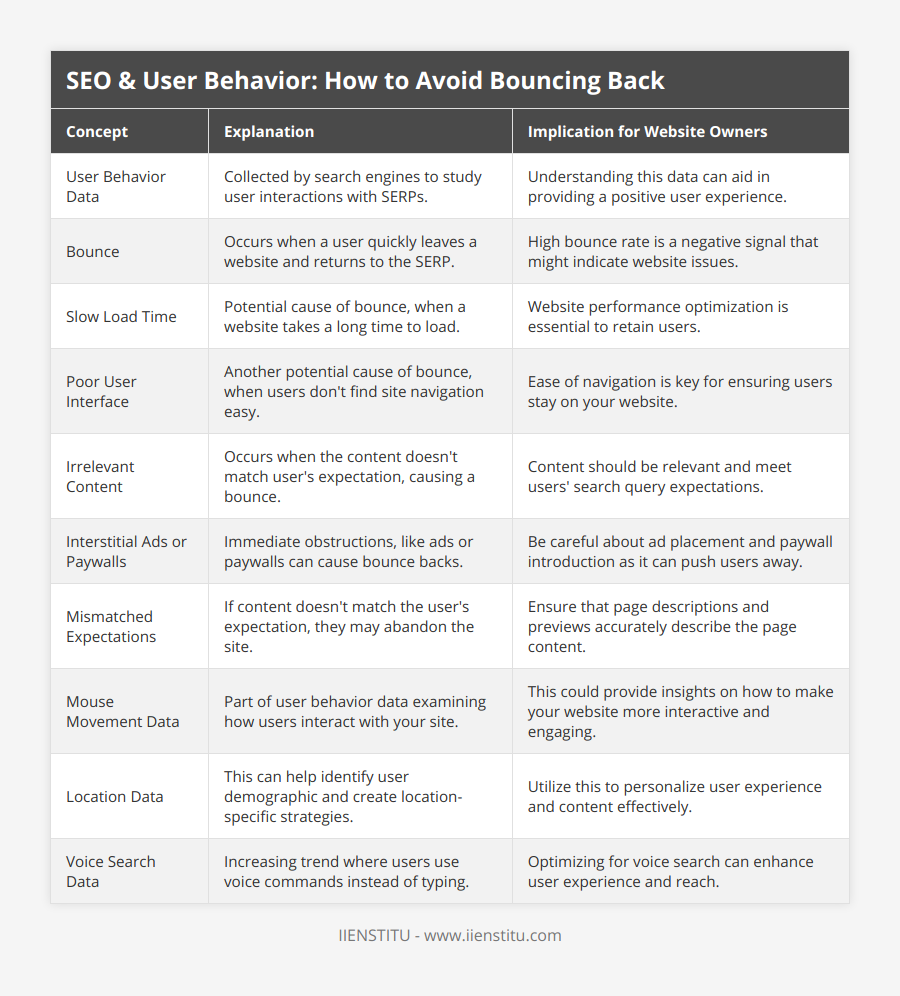
Frequently Asked Questions
What strategies can be used to reduce user bouncing on a website?
User bouncing is a common issue website owners face, as it can decrease the website's visibility and overall effectiveness. User bouncing occurs when a visitor to a website visits only one page on the website before leaving without visiting any other page. This can be a significant problem for websites as it can decrease their visibility and overall effectiveness.
Several strategies can be used to reduce user bouncing on a website. The first strategy is to design an effective website navigation system. A website that is difficult to navigate or does not have an intuitive navigation system can lead to a user bouncing from the website. Therefore, it is essential to ensure that the navigation system is easy to use and understand, as this will make it easier for users to find what they are looking for and to stay on the website.
The second strategy is to create content relevant to the website's visitors. Content not applicable to visitors will likely lead to users bouncing from the website. Therefore, it is essential to ensure that the content on the website is relevant to the visitors and that they will find it exciting and engaging.
The third strategy is to create a practical website layout. A website cluttered or difficult to read will likely lead to users bouncing from the website. Therefore, creating a website layout that is easy to read and navigate is essential, as this will make it easier for users to find information and stay on the website.
The fourth strategy is to create a compelling call to action. Calls-to-action is essential for keeping visitors on a website. It can encourage users to take specific actions, such as signing up for a newsletter or purchasing a product. Therefore, it is essential to ensure that the call-to-action is compelling and placed in the right location on the website, as this will make it more likely that users will take the desired action.
Finally, it is essential to use analytics to track user behavior on the website. Using analytics, website owners can identify which pages are causing user bouncing and take steps to improve them. This will help to reduce user bouncing and increase the effectiveness of the website.
In conclusion, several strategies can be used to reduce user bouncing on a website. These strategies include creating an effective website navigation system, creating content relevant to the website's visitors, creating a practical website layout, creating a compelling call-to-action, and using analytics to track user behavior. By implementing these strategies, website owners can reduce user bouncing and increase the website's effectiveness.
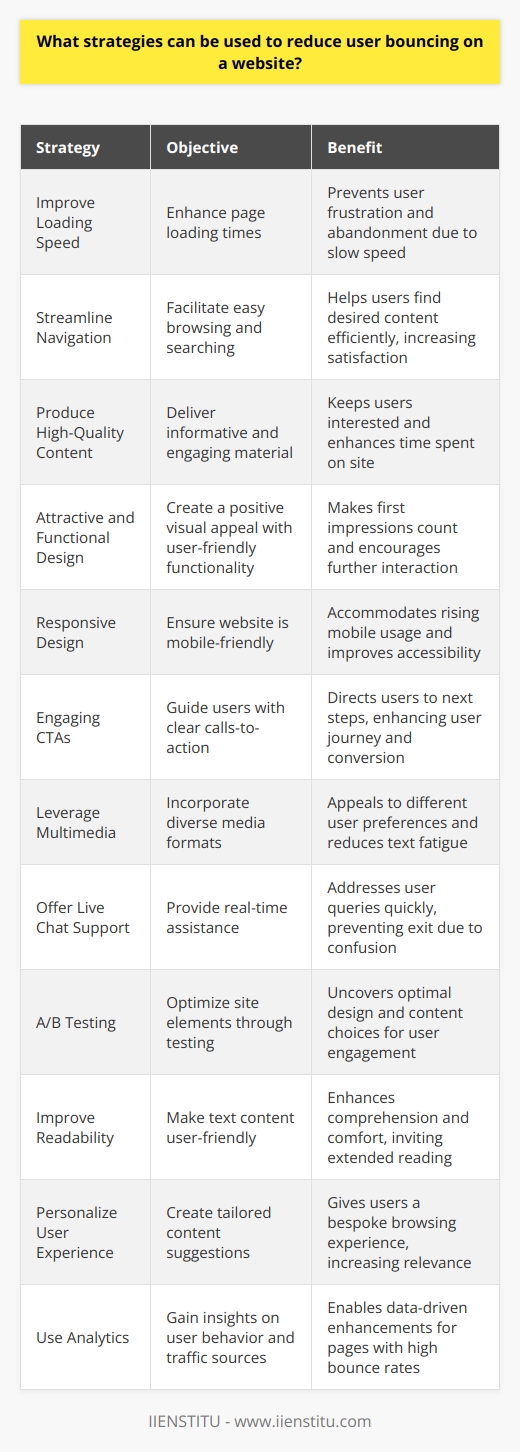
How does SEO affect user behavior and bouncing?
Search engine optimization, commonly referred to as SEO, is essential for any website. SEO is optimizing a website to be more easily found and indexed by search engines like Google, Yahoo, and Bing. This process involves using keywords, meta descriptions, and other techniques to help a website rank higher in search engine results.
However, SEO is not only used to improve a website’s search engine rankings. It can also be used to influence user behavior and reduce bouncing. Bouncing is when a user visits a website and immediately leaves without spending any time on the site.
The primary way in which SEO can affect user behavior is through the use of targeted keywords. When a website is optimized for relevant keywords and phrases, it can help to attract more visitors who are interested in the topic. This can help to reduce bouncing and increase the time that the user spends on the website.
SEO can also be used to create a positive user experience. For example, websites adequately optimized for search engines are more likely to be organized, easy to navigate, and have relevant content. This makes it easier for the user to find what they are looking for and engage with the content.
Finally, SEO can also be used to improve page loading speed. Websites that are slow to load can be a significant cause of bouncing. Conversely, a website optimized for search engines will typically load quickly, making it more likely that the user will stay and view the content.
In conclusion, SEO can be a powerful tool for improving user behavior and reducing bouncing. By optimizing a website for relevant keywords, creating a positive user experience, and improving page loading speed, SEO can help to reduce bouncing and enhance the overall user experience.

What are the best practices for optimizing a website to reduce user bouncing?
Regarding website optimization, reducing user bouncing is a critical goal. User bouncing occurs when a user visits a website and leaves without taking any action, such as clicking a link or filling out a form. Bouncing directly impacts website performance as it limits the amount of time users spend on the website and reduces the chances of conversions. Therefore, website owners need to optimize their websites to reduce user bouncing.
The following are best practices for optimizing a website to reduce user bouncing.
The first step is to ensure that the website loads quickly. This can be done by optimizing images, reducing the size of files, and compressing code. Additionally, it’s essential to ensure the website is mobile-friendly, as many users access websites from their smartphones.
The second step is to create a straightforward navigation structure. This means having clear and concise labels for each page and creating a hierarchy for the runners. This will help users find what they are looking for quickly and easily.
The third step is to create a good user experience. This includes ensuring the website is visually appealing, easy to use, and provides clear and concise information. Additionally, it’s essential to ensure that the website has a clear call to action so that users know what to do next.
The fourth step is to ensure that the website is up-to-date. This means making sure that the content is consistently updated and relevant. Additionally, it’s essential to keep the website design modern and to ensure that all features are functioning correctly.
Finally, it’s important to track user behavior and analyze the results. This will help identify areas for improvement and enable website owners to make changes that will reduce user bouncing.
By following these best practices, website owners can optimize their websites to reduce user bouncing. Doing so will improve the user experience and increase the chances of conversions.

How do I reduce bounce rate in Google Analytics and improve my website's SEO standing?
**Understanding Bounce Rate**
Bounce rate refers to the percentage of visitors who leave a website after viewing only one page, without exploring further or interacting with any elements. A high bounce rate can negatively impact a website's search engine optimization (SEO), as it indicates that users aren't finding the content engaging or valuable.
**Effective Content Strategy**
To reduce the bounce rate and improve the website's SEO standing, an effective content strategy should be implemented. This includes creating high-quality, engaging, and relevant content that appeals to the target audience. Tailor the content to address users' needs and provide clear value, ensuring that it is easily digestible with the use of shorter sentences and less difficult words.
**User-Friendly Web Design**
Additionally, a user-friendly web design plays a vital role in reducing the bounce rate. Optimize the website's layout, ensuring that it is easy to navigate and that the most important information is prominently displayed. Implementing a mobile-friendly design will also accommodate users browsing from various devices, further enhancing the overall user experience.
**Page Load Speed Optimization**
Another crucial factor to consider is the website's loading speed. Slow-loading pages can significantly increase the bounce rate, as users quickly lose patience and leave the site. Optimize images, utilize browser caching, and eliminate unnecessary plugins or scripts to improve load speed and user experience, reducing the likelihood of bouncing.
**Intuitive Internal Linking**
Well-placed internal links within the content can encourage users to explore the website further, thus decreasing the bounce rate. Implement an intuitive and easy-to-follow internal linking structure that connects relevant content, keeping users engaged and providing them with more helpful information.
**Compelling Call-to-Action**
Finally, incorporating a compelling call-to-action (CTA) can help retain users and encourage them to take further actions on the site, such as subscribing to a newsletter, downloading an e-book, or buying a product. A clear and persuasive CTA can prompt users to engage, contributing to a lower bounce rate and improved SEO.
In conclusion, reducing the bounce rate and improving a website's SEO standing require a comprehensive approach that includes content strategy, web design, load speed optimization, internal linking, and effective calls-to-action. By addressing these factors, websites can effectively capture and retain users' interest, ultimately enhancing their online presence and search engine ranking.
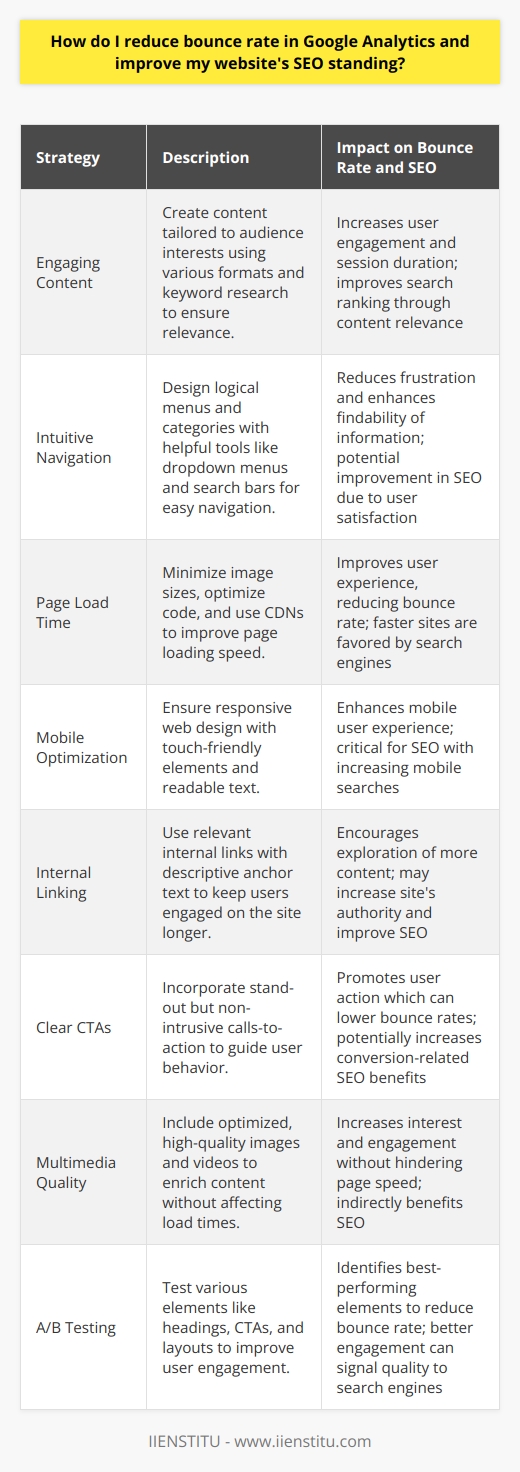
What factors contribute to a high bounce rate and how can they be mitigated to enhance SEO?
Factors Causing High Bounce Rate
Various factors contribute to a high bounce rate in a blog post. The primary factors include a lack of relevant content, insufficient internal linking, slow page load times, cumbersome navigation, and intrusive advertisements. Addressing these issues can significantly improve user experience, reduce bounce rate, and enhance search engine optimization (SEO).
Improving Content Relevance
To prevent users from quickly leaving a blog post, the content must be engaging and relevant. Ensuring the blog post's title, subheadings, and opening paragraphs accurately reflect its content helps to attract targeted users. Furthermore, adopting a conversational writing style and utilizing simpler language can make the post more appealing and accessible to a broader audience.
Enhancing Internal Linking
Inadequate internal linking can result in users not exploring other pages on the website. By embedding relevant links within the content, users can be prompted to visit related articles and stay longer on the site. Additionally, supplementary resources such as related posts or recommended readings can be displayed to prolong user engagement.
Optimizing Page Load Speed
Slow page load times impact the bounce rate negatively, as users might not have the patience to wait for content to load. Optimizing images, using browser caching, and minimizing the use of scripts and plugins can significantly reduce load times. Moreover, employing a content delivery network (CDN) and ensuring the website is mobile-friendly can improve performance and user experience.
Simplifying Navigation
Complicated navigation can deter users from exploring the website further. To alleviate this issue, it is critical to design a clear, simple, and intuitive website layout. Providing clear categories and navigational menus can substantially enhance user experience and reduce bounce rates.
Reducing Intrusive Advertisements
Intrusive advertisements can detract from a user's experience, leading to a higher bounce rate. Limiting the number of ads, avoiding pop-up messages, and ensuring the ads are relevant to the content can improve user satisfaction and reduce bounce rates.
Conclusion
By addressing the causes of high bounce rates, a blog post's SEO can be significantly enhanced. Improving content relevance, optimizing internal linking, increasing page load speed, simplifying navigation, and reducing intrusive advertisements are crucial steps in addressing this issue, ultimately leading to better user experience and overall website performance.
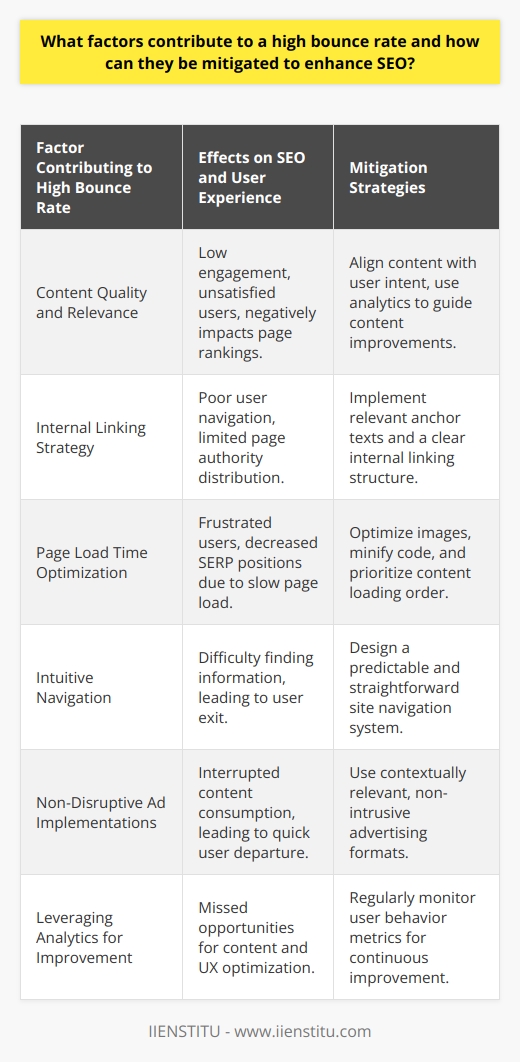
How do user engagement and content relevancy impact bounce rate and overall SEO performance?
User Engagement and Bounce Rate
User engagement is a crucial factor in determining the bounce rate, which further influences the overall search engine optimization (SEO) performance. When users find a blog post engaging, they spend more time on the page, interacting with the content, and exploring the website. Longer session durations and lower bounce rates signal search engines like Google that the content is valuable, relevant, and valuable, leading to improved SEO performance and higher rankings in search results.
Content Relevancy and Bounce Rate
Content relevancy also plays a critical role in influencing bounce rate and SEO performance. If a blog post accurately addresses a user's query or interest, the visitor is more likely to stay on the page and continue engaging with the website. In contrast, irrelevant content may compel the user to leave the website immediately, resulting in an increased bounce rate. Higher bounce rates send negative signals to search engines, affecting the website's credibility and rankings in search engine results pages (SERPs).
Incorporating Multimedia Elements
Incorporating multimedia elements such as images, videos, infographics, and interactive content can significantly enhance user engagement and decrease bounce rate. Multimedia elements break up the monotony of text-heavy blog posts, enabling faster information processing and increasing user satisfaction. However, it is crucial to ensure that multimedia elements are relevant and strategically placed within the blog post to maintain the visitor's interest and boost retention.
Improving Website Design and User Experience
A well-designed website with an intuitive layout and straightforward navigation can significantly affect user engagement and bounce rate. Ensuring users can quickly access desired content and understand the website's structure will increase the likelihood of them spending more time on the site. Additionally, optimizing the blog for mobile devices and improving page load times will ensure users have a seamless experience, leading to increased engagement rates and benefiting overall SEO performance.
In conclusion, user engagement and content relevancy are vital factors affecting bounce rate and SEO performance. By creating engaging, relevant content, incorporating multimedia elements, and focusing on website design and user experience, blog owners can minimize bounce rate and maximize the site's SEO potential.

How does bounce rate affect SEO and website performance?
Impact on SEO
Bounce rate significantly affects Search Engine Optimization (SEO) by influencing a website's rank on search engine results pages (SERPs). A high bounce rate indicates that users are leaving the site quickly after entering, which may signal to search engines that the site is not providing relevant or engaging content. Consequently, search engines may lower the site's rank in SERPs, leading to decreased visibility and organic traffic.
User Experience
A high bounce rate is also indicative of a poor user experience, which may stem from various factors such as slow page load times, unappealing design, or lack of clear navigation. Inadequate user experiences on a website typically result in users abandoning the site quickly, leading to a high bounce rate. This negative effect on user engagement hampers website performance, as it decreases the likelihood of users interacting with the site and sharing its content.
Conversion Rates
Website performance is also measured by its conversion rates, which are negatively impacted by a high bounce rate. When users leave a site prematurely, the opportunity to convert those visits into desired outcomes, such as product purchases or newsletter subscriptions, is lost. As a result, a high bounce rate reduces a site's ability to achieve its goals and succeed in the competitive online environment.
Strategies to Lower Bounce Rate
To improve both SEO and website performance, it is crucial to lower the bounce rate by optimizing various aspects of the site. First, ensure that the page loads quickly and displays correctly on all devices, as slow or unresponsive pages are key factors in driving users away. Second, create engaging, informative, and relevant content that meets user expectations and encourages them to explore the site further. Lastly, optimize the site's navigation and design to facilitate an enjoyable and intuitive user experience.
In conclusion, bounce rate is a critical metric that affects SEO and overall website performance. By optimizing content, website design, and user experience, website owners can lower their site's bounce rate and improve its likelihood of achieving its goals—thus positively impacting both search engine visibility and user engagement.
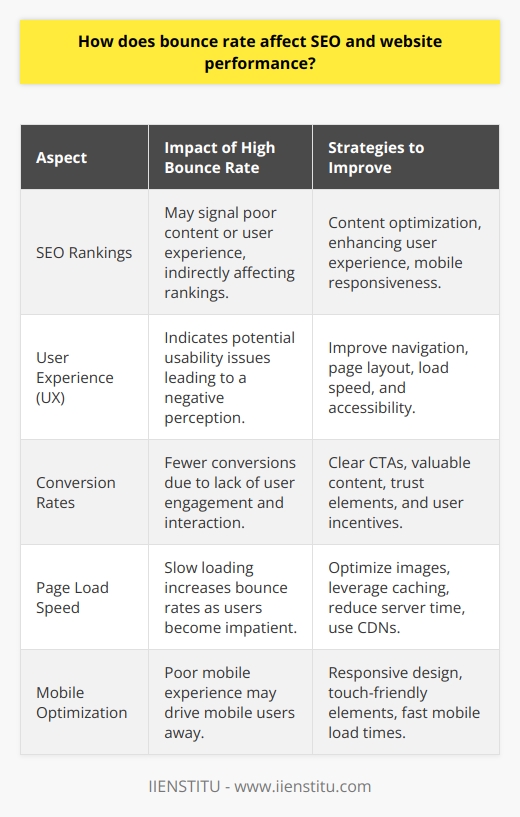
What role does website design play in influencing bounce rate and SEO outcomes?
Impact of Website Design on Bounce Rate
Website design plays a crucial role in influencing the bounce rate, which refers to the proportion of people who visit a web page only to leave immediately without engaging with its content. A well-designed website can help to lower the bounce rate by providing a pleasant user experience, making it easy for visitors to find what they are looking for, and encouraging them to explore further.
User Experience and Navigation
To provide a pleasant user experience, website design should prioritize ease of use, quick loading times, and mobile responsiveness. Streamlined navigation and clear calls to action can guide the user toward desired content, reducing the likelihood of bouncing. Moreover, optimizing your webpage for mobile devices can help in retaining mobile users by creating a user-friendly website and influencing the bounce rate positively.
Content Presentation and Visual Elements
The way the content is presented on a site can significantly impact the bounce rate. Readable fonts, logical organization of content, and appropriate use of white space can improve readability and help retain the user’s attention. Additionally, the use of visually appealing yet functional design elements, such as images and videos, can enhance user engagement and further reduce the bounce rate.
Impact on SEO Outcomes
A lower bounce rate can positively affect a website's search engine optimization (SEO) outcomes. Search engine algorithms, such as Google's, consider bounce rate as a signal regarding the relevance and quality of the content on a site. Thus, by improving website design and subsequently reducing the bounce rate, a webpage is more likely to perform better in search engine rankings. This improved visibility can result in higher organic traffic, boosting the site’s overall online presence.
In conclusion, the design of a website has a significant influence on bounce rate and SEO outcomes. To enhance user experience, web designers should focus on ease of navigation, mobile responsiveness, content presentation, and engaging visuals. These improvements can help lower the bounce rate, leading to better search engine rankings and increased website visibility.
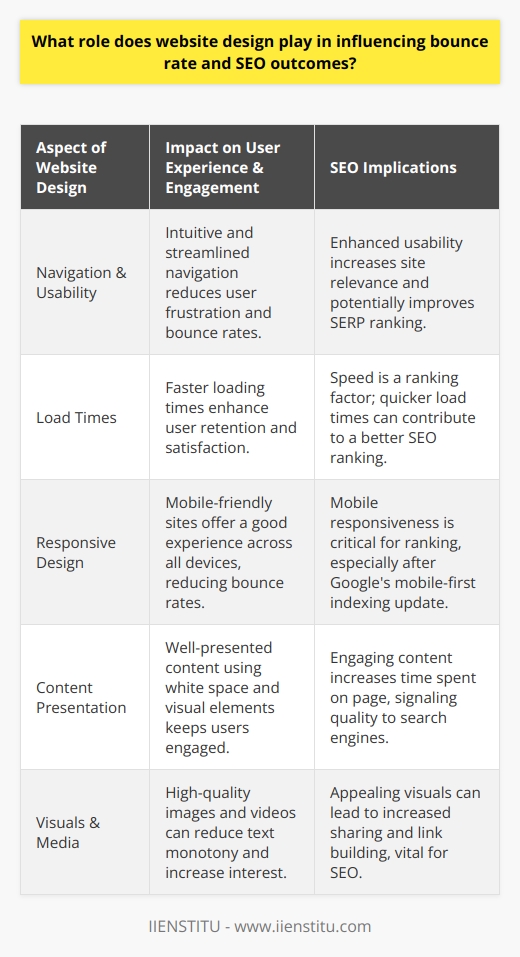
How can improving site navigation and loading speed contribute to reducing bounce rate and enhancing SEO?
Site Navigation Improvement
Improving site navigation can play a significant role in reducing bounce rate and enhancing SEO for a blog post. A well-structured, easily accessible, and user-friendly layout enables users to locate information quickly. When visitors find relevant content effortlessly, the likelihood of them spending more time on the site increases, leading to a lower bounce rate. Consequently, search engines perceive the website as relevant and valuable for users, which positively impacts its search engine rankings.
Loading Speed Optimization
An optimized loading speed is another crucial factor in decreasing bounce rates and improving SEO performance. When a website loads quickly, it provides a better user experience and helps maintain the interest of the visitors. The longer users stay on a site, the more opportunities they have to engage with the content, ultimately leading to a lower bounce rate. Additionally, search engines like Google prioritize websites with faster loading times in their rankings. Therefore, enhancing loading speed not only improves user satisfaction but also contributes positively to the overall SEO performance.
Intuitive Design and Content Organization
Incorporating intuitive design and proper content organization supports a blog's SEO and bounce rate efforts. Clear and concise headings, subheadings, lists, and visual aids enhance content readability and make navigation simpler for users. When visitors can easily scan and locate relevant information on a blog, they are more likely to consume the content and explore further pages, decreasing the bounce rate. A well-organized and easily navigable blog also signals to search engines that the website is user-centric, contributing to better SEO rankings.
In conclusion, improving site navigation and loading speed are essential strategies for reducing bounce rate and enhancing SEO. By making it easier for users to find and consume relevant content, these improvements promote user engagement and satisfaction, ultimately leading to better search engine rankings and overall website performance.

How do I reduce SEO bounce rate while maintaining a user-focused website design?
Understanding Bounce Rate in SEO Context
Bounce rate is the percentage of website visitors who leave after viewing just one page, which negatively affects search engine rankings. To reduce bounce rate while maintaining a user-focused website design, blog owners should consider several strategic modifications that enhance user experience, encourage engagement, and improve site navigation.
Implementing User-Friendly Design Elements
Optimizing user experience involves making the site visually appealing and easy to navigate by adopting a clean, clutter-free design and a well-defined content hierarchy. Additionally, site owners should ensure website layouts are responsive and equipped for various devices, guaranteeing an optimal browsing experience across smartphones, tablets, and desktops.
Choosing Appropriate and Readable Typography
The selection of typeface and font size plays a vital role in retaining user attention. Bloggers should choose legible fonts with proper spacing and utilize contrasting colors between text and background to improve readability. Furthermore, employing bulleted lists or numbered steps to break down lengthy content can facilitate easy reading for site visitors.
Creating Engaging Content with Clear Subheadings
To maintain user interest, bloggers should provide insightful, engaging, and well-researched content that meets readers' demands by addressing their queries or concerns. Furthermore, content should be suitably structured with clear subheadings to help readers locate information by scanning the content quickly.
Incorporating Internal Links and Call to Actions
Strategically embedding internal links within blog posts can extend the user's navigation journey and encourage them to explore additional site resources. Moreover, incorporating persuasive call-to-action (CTA) buttons that prompt readers to subscribe, comment, or share the content can significantly improve engagement levels and reduce bounce rate.
Optimizing Page Load Time
Fast-loading websites are essential for user satisfaction. Site owners should optimize page speed by compressing images, minimizing JavaScript and CSS files, and employing efficient caching mechanisms. These efforts contribute to improved website performance, encouraging users to stay and explore the site further.
In conclusion, reducing bounce rate while upholding a user-centric website design involves optimizing user experience, providing clear and appealing content, utilizing internal links, and optimizing website performance. By implementing these strategies, blog owners can effectively engage users, enhance their satisfaction, and improve search engine rankings.
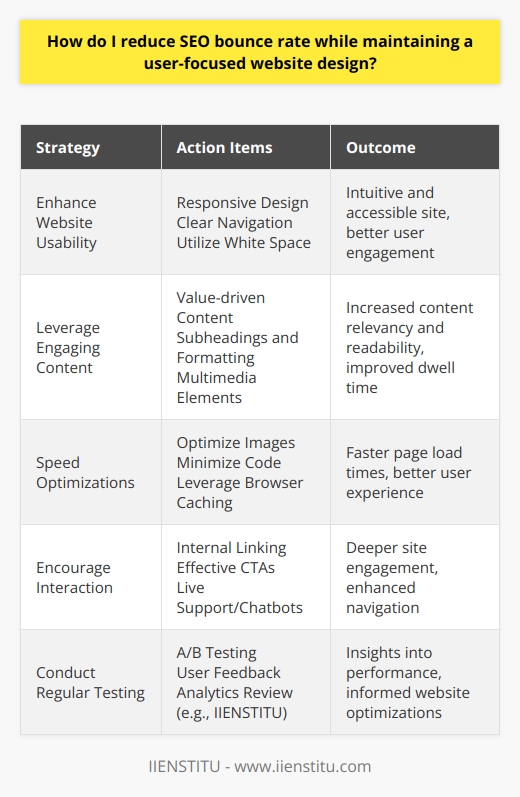
Is bounce rate important in SEO and what are its implications on user experience and search engine ranking?
Bounce Rate Significance in SEO
Undoubtedly, bounce rate serves as a significant metric in search engine optimization (SEO) for gauging user experience and search engine ranking. A high bounce rate denotes that visitors leave a website almost immediately after landing on it, which may indicate either irrelevant or low-quality content. Consequently, search engines will recognize this as a poor user experience and downgrade the site's ranking, affecting its overall visibility.
User Experience Implications
Considering that user experience is crucial for website success, poor bounce rate management can have adverse effects in this regard. For instance, visitors may encounter difficulties in navigation, deterring them from engaging further. Additionally, the content might not be sufficiently engaging or relevant to their needs, leading them to exit the website rapidly. Addressing these user experience concerns is essential to minimize bounce rates and retain user interest, contributing positively to website performance and SEO.
Search Engine Ranking Consequences
Given that search engine algorithms prioritize user experience, a high bounce rate can severely impact search engine ranking. Search engines infer that a site with a high bounce rate fails to provide valuable or relevant content, and thus, may consider other more suitable options. As a result, the website's ranking and visibility can decrease, effectively limiting its potential to attract organic traffic.
Effectiveness of Bounce Rate as a Metric
However, it is important to note that bounce rate should not be regarded as the sole determinant of a website's success. Various factors can contribute to an increased bounce rate, such as page loading time or design flaws. Hence, it is crucial to holistically assess the user experience and address any shortcomings. Furthermore, analyzing different website sections and user segments can provide deeper insights into patterns and trends, thereby refining the optimization strategy.
In conclusion, bounce rate remains an important metric in SEO, influencing user experience and search engine ranking. Ensuring a low bounce rate requires attention to content quality, navigational aspects, and website performance, as well as a nuanced understanding of user behavior and preferences. Ultimately, a website's success relies on comprehensively addressing these factors and persistently seeking opportunities for improvement.
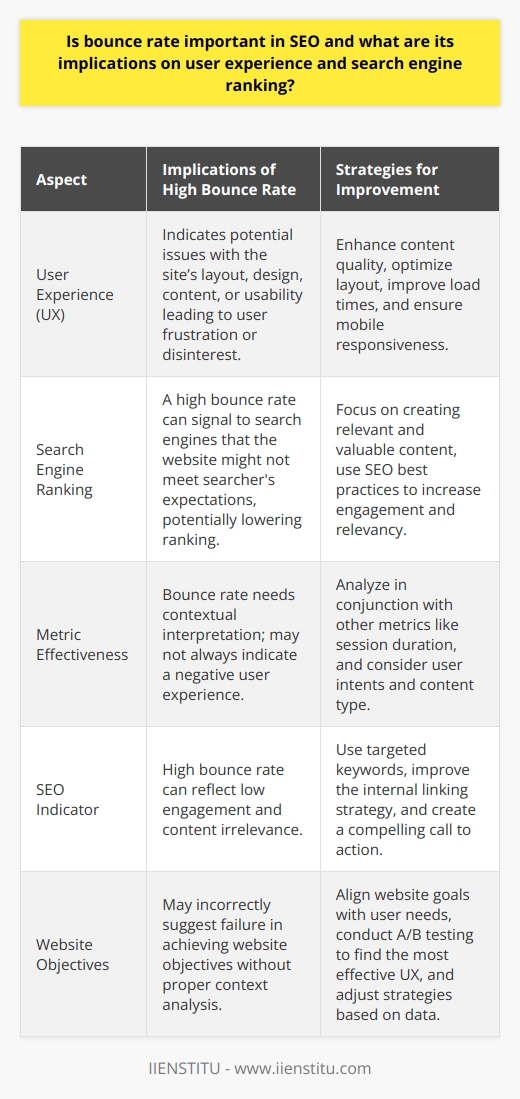
How does user behavior, such as dwell time and click-through rate, affect SEO and contribute to a website's bounce rate?
User Behavior and SEO
User behavior strongly influences a website's search engine optimization (SEO) performance. Two crucial elements of user behavior, dwell time and click-through rate, significantly contribute to a website's bounce rate, which in turn impacts SEO rankings.
Dwell Time's Influence
Dwell time is the duration a user spends on a website after clicking through from a search engine results page (SERP). High dwell times signal that visitors find the content valuable and engaging. Search engines interpret this as a positive indication of the website's relevance and quality, leading to better SEO ranking positions.
Click-Through Rate Impact
The click-through rate (CTR) is the ratio of users who click on a website's link to the total number who view the SERP. A high CTR implies that the meta title and description effectively entice users to visit the website. This translates to better SEO performance, as search engines deduce that the site provides relevant information matching the search intent.
Bounce Rate Connection
The bounce rate is the percentage of single-page visits, where users leave the website without interacting with the content or navigating to other pages. A high bounce rate signals poor user engagement and indicates that the website might not provide relevant, valuable, or accessible content. Search engines may interpret this as a sign that the site is not meeting users' needs or expectations, thereby hindering its SEO rankings.
Minimizing Bounce Rate
To reduce bounce rate and optimize SEO rankings, websites must create content that is relevant, valuable, and engaging. This includes using eye-catching titles, providing answers to user queries, and presenting information in an easy-to-read format. Additionally, improving site speed, enhancing mobile-friendliness, and refining internal linking strategies can also contribute to lower bounce rates and better SEO performance.
In conclusion, user behavior, particularly dwell time and click-through rate, directly affects a website's bounce rate, which in turn influences its SEO rankings. To optimize SEO performance, it is essential for website owners to pay close attention to these user experience aspects and implement strategies to enhance users' engagement with their content.



